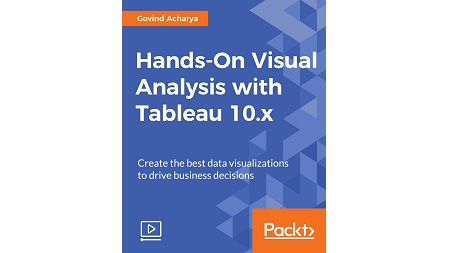
English | MP4 | AVC 1920×1080 | AAC 48KHz 2ch | 5h 20m | 1.14 GB
Drive decision making by creating high-impact data visualizations. Perform visual analysis on your data using Tableau.
Tableau has brought the world of visual analytics within the reach of many nonplussed by Excel charts and graphs. But there is a surprising learning curve that gets in the way of using Tableau to its full potential; this course will show you how visual and cognitive science makes data visualization so satisfying. This course will give you the tools to use Tableau to its fullest and build great visualizations.
In this course, you will begin by understanding a data-visualization business case with Tableau. Next you will learn about complex ways to connect your data. Moving ahead, you will explore how to express your data—ranging from standard bar charts to more cutting-edge visuals—and make data interactive using sets, filters, groups, and hierarchies. Next you will understand how advanced calculation techniques help improve visual analysis. You will also learn about Tableau’s powerful tools (such as spatial analysis) to create maps that are embedded with your data. Lastly you will learn how to put all of your work together into dashboards.
By the end of this course you will have gained a lot of confidence, which you can use to build useful, thoughtful, and beautiful visualizations using your complex business data.
We use a hands-on, step-by-step approach to build on your knowledge of Tableau. Each section will build on another so that, by the time you’ve completed the course, you will be able to visualize data much more effectively with Tableau.
What You Will Learn
- Improve decision-making using visual analytics.
- Connect to a single data source and multiple data sources that are linked
- Implement calculations in a variety of ways to get insights from your data.
- Develop spatial visualizations
- Use parameters to help your audience visualize data
- Build dashboards that have actions and filters.
- Create the best visualizations by learning important tips, tricks, and timesavers
Table of Contents
Getting Started with Tableau
1 The Course Overview
2 Installation and Setup
3 The Business Case for Visualizations
4 Deep Dive into Tableau File Types
Connect Your Data in Tableau
5 Understanding the Ways to Connect to Data
6 Planning and Saving Data Sources
7 Choosing Live or Extract Data Sources
8 Calculations in the Data Source Page
9 Data Shaping and Data Quality
10 Working with the Data Interpreter
11 Joins and Blends
Tableau Prep
12 Installing Tableau Prep
13 Importing Data into Tableau Prep
14 Editing and Seeing Changes After Editing
15 Tableau Prep’s – Smart Features
Building Your First Visualizations
16 Using the “Show Me” Function to Create Horizontal, Stacked, and Side-by-Side Bar Charts
17 Using the “Show Me” Function to Create Line and Area Charts
18 Using the “Show Me” Function to Create Scatter Plots
19 Using the “Show Me” Function to Create Tree Maps and Packed Bubbles
20 Working with the Analytics Tab
Enhancing Your Data with Filters and Groups
21 Working with Filters
22 Using Sets
23 Advanced Usage of Sets
24 Creating Groups
25 Creating Hierarchies
Creating Artful Analytics with Calculations
26 Calculated Fields and Visualizations
27 Table Calculations and Visualizations
28 Using Ad Hoc Calculated Fields
29 Understanding Aggregations
30 Reusing, Customizing, Secondary, and Other Table Calculation Functions
31 Exploring Level of Detail Expressions
Using Spatial Data to Improve Insight
32 Reviewing Standard Map Visualizations
33 Understanding Geocoding
34 Tips and Tricks in Dealing with Mapping Errors
35 Working with Custom Geocoding
36 Using Background Images in Spatial Visualizations
Advanced Calculations and Parameters
37 Working in an Ad Hoc Analysis Environment
38 Exploring Higher Level of Detail Expressions
39 Using Parameters to Control Variables
40 Using Parameters to Aid Insight
41 Advanced Calculation to Create Small Multiple Charts
Dashboards for Stories
42 When to Use and When Not to Use Dashboards
43 Applying Recommended Best Practices in Dashboard Construction
44 Performing Dashboard Actions
45 Formatting for the Audience
46 Building the Ultimate Dashboard
47 Weaving Your Story
Resolve the captcha to access the links!